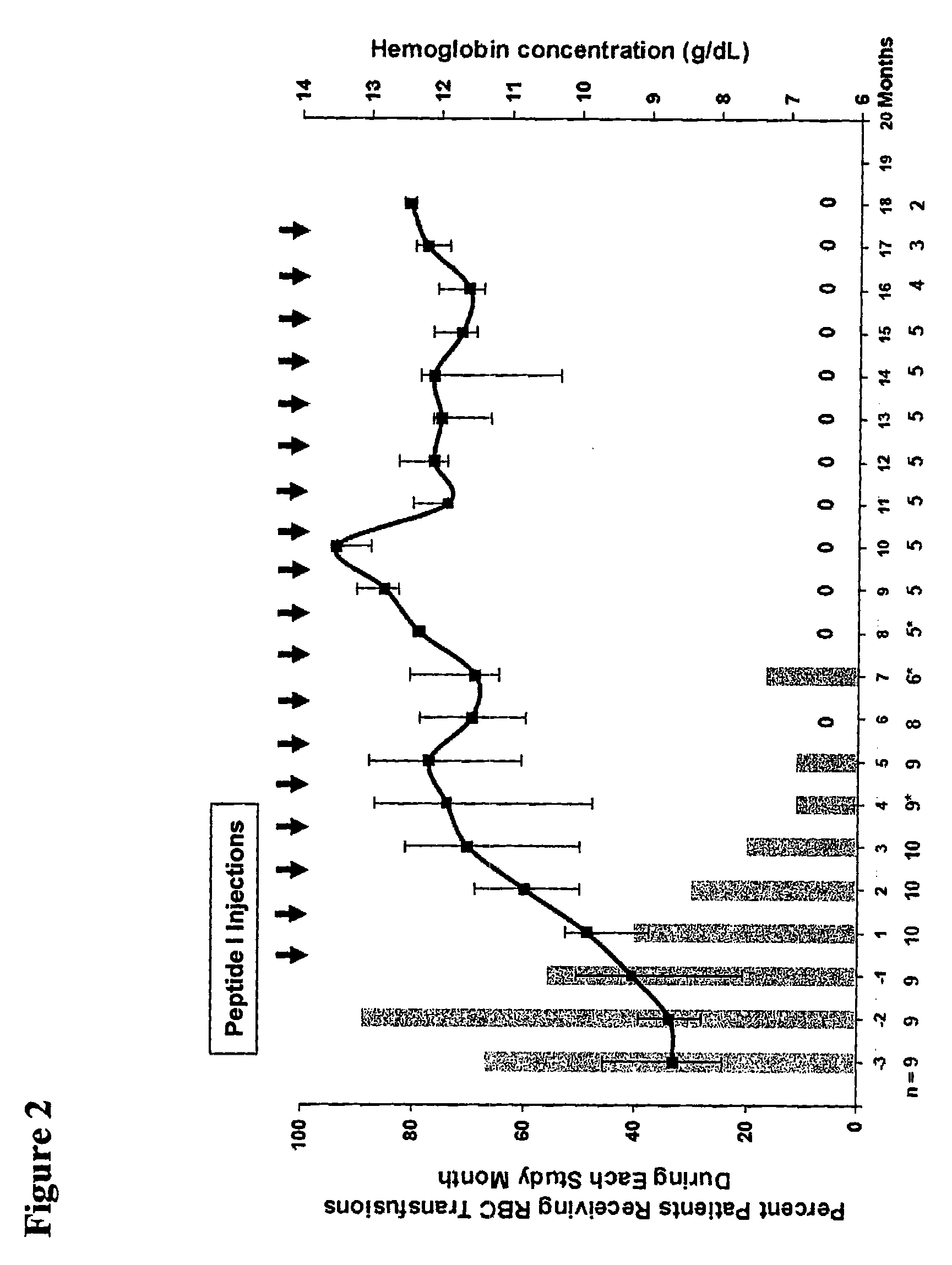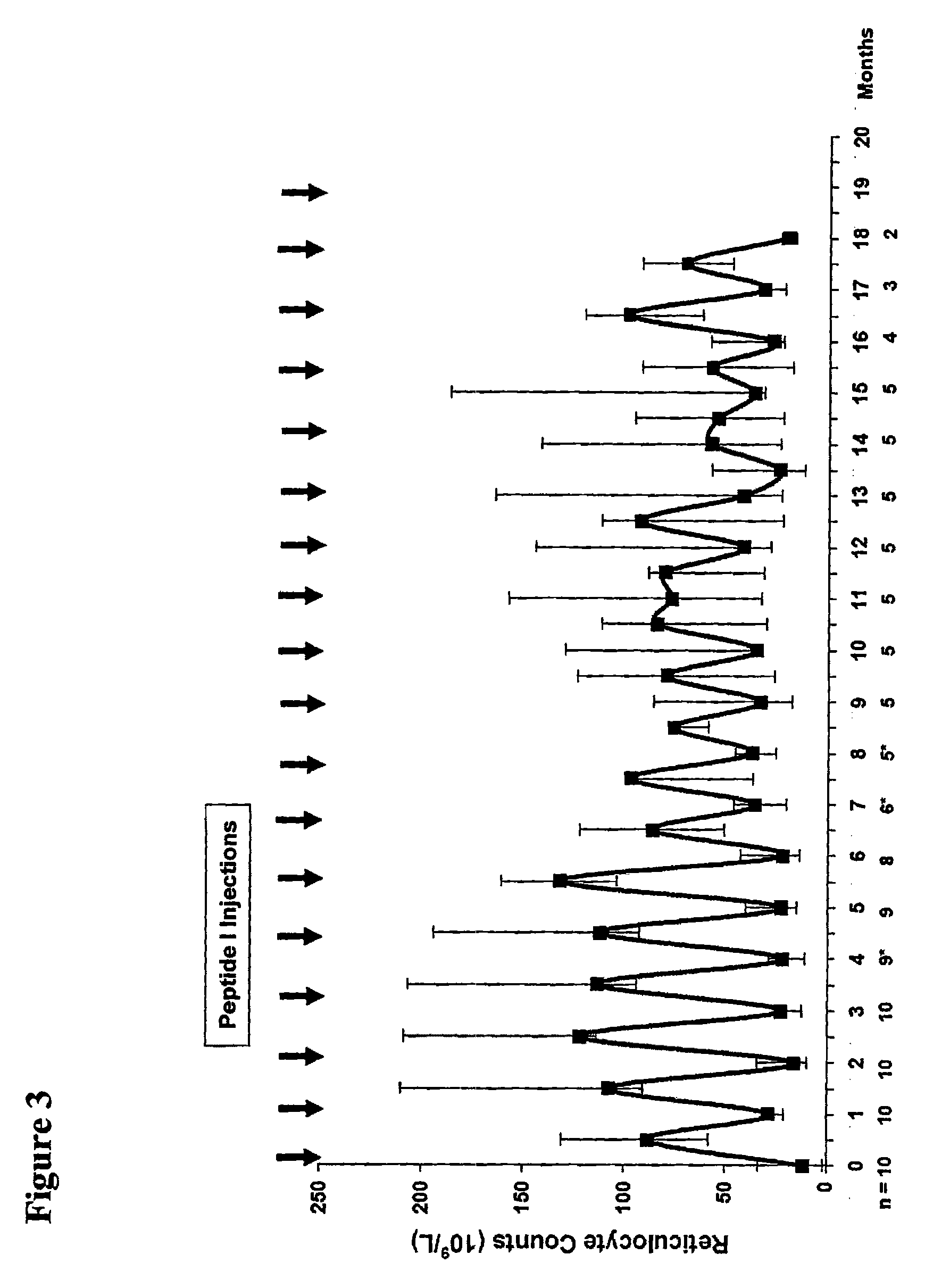Treatment of Anti-erythropoietin antibody-mediated disorders with synthetic peptide-based epo receptor agonists
a technology of erythropoietin and epo receptor, which is applied in the field of peptide compounds, can solve the problems that the neutralizing effect of antibodies cannot be overcome with increasing doses, the potential risk of anti-epo antibody generation may also affect the development and use of esas, and the treatment of anti-epo antibody-mediated prca to date is problematic, so as to prevent or reduce the incidence of a disorder, increase or restore hemoglob
- Summary
- Abstract
- Description
- Claims
- Application Information
AI Technical Summary
Benefits of technology
Problems solved by technology
Method used
Image
Examples
example 1
Synthesis of EPO-R Agonist Peptide Dimers by Solid Phase Synthesis
[0167]Step 1—Synthesis of Cbz-TAP: A solution containing the commercially available diamine (“TAP” from Aldrich Chemical Co.) (10 g, 67.47 mmol) in anhydrous DCM (100 ml) was cooled to 0° C. A solution of benzyl chloroformate (4.82 ml, 33.7 mmol) in anhydrous DCM (50 ml) was added slowly through a dropping funnel over a period of 6-7 h, maintaining the temperature of the reaction mixture at 0° C. throughout, then allowed to warm to room temperature (˜25° C.). After a further 16 h, the DCM was removed under vacuum and the residue partitioned between 3N HCl and ether. The aqueous layers were collected and neutralized with 50% aq. NaOH to pH 8-9 and extracted with ethyl acetate. The ethyl acetate layer was dried over anhydrous Na2SO4, and then concentrated under vacuum to provide the crude mono-Cbz-TAP (5g, about 50% yield). This compound was used for the next reaction without any further purification.
[0168]Step 2—Synthe...
example 2
Synthesis of EPO-R Agonist Peptide Dimers by Fragment Condensation
[0178]Step 1—Synthesis of (Cbz)2-Lys: Lysine is reacted under standard conditions with a solution of benzyl chloroformate to obtain lysine protected at its two amino groups with a Cbz group.
[0179]Step 2—Synthesis of Boc-TAP: Boc-TAP is synthesized as described in Steps 1 through 3 of Example 1.
[0180]Step 3—Coupling of (Cbz)2-Lys and Boc-TAP: (Cbz)2-Lys and Boc-TAP are coupled under standard coupling conditions to obtain (Cbz)2-Lys-TAP-Boc.
[0181]Step 4—Lys-TAP-Boc: The crude product from the previous reaction is dissolved in methanol (25 ml) and hydrogenated in presence of 5% Pd on Carbon (5% w / W) under balloon pressure for 16 hrs. The mixture is filtered, washed with methanol and the filtrate concentrated in vacuo to provide the crude Lys-TAP-Boc product
[0182]Step 5—Synthesis of peptide monomers by fragment condensation: Four peptide fragments of the peptide monomer sequence are synthesized by standard techniques. The...
example 3
In Vitro Activity Assays
[0187]This example describes various in vitro assays that are useful in evaluating the activity and potency of EPO-R agonist peptides of the invention. The results for these assays demonstrate that the novel peptides of this invention bind to EPO-R and activate EPO-R signaling. Moreover, the results for these assays show that the novel peptide compositions exhibit a surprising increase in EPO-R binding affinity and biological activity compared to EPO mimetic peptides that have been previously described.
[0188]EPO-R agonist peptide dimers are prepared according to the methods provided in Example 1 or Example 2. The potency of these peptide dimers is evaluated using a series of in vitro activity assays, including: a reporter assay, a proliferation assay, a competitive binding assay, and a C / BFU-e assay. These four assays are described in further detail below.
[0189]The results of these in vitro activity assays are summarized in Table 2.
1. Reporter Assay
[0190]This...
PUM
| Property | Measurement | Unit |
|---|---|---|
| body weight | aaaaa | aaaaa |
| body weight | aaaaa | aaaaa |
| concentrations | aaaaa | aaaaa |
Abstract
Description
Claims
Application Information
 Login to View More
Login to View More - R&D
- Intellectual Property
- Life Sciences
- Materials
- Tech Scout
- Unparalleled Data Quality
- Higher Quality Content
- 60% Fewer Hallucinations
Browse by: Latest US Patents, China's latest patents, Technical Efficacy Thesaurus, Application Domain, Technology Topic, Popular Technical Reports.
© 2025 PatSnap. All rights reserved.Legal|Privacy policy|Modern Slavery Act Transparency Statement|Sitemap|About US| Contact US: help@patsnap.com



